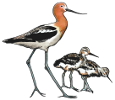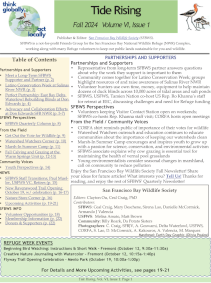SFBWS at the USFWS Regions 1 and 8 conference for Service staff and Friends Groups
by Ceal Craig
Visiting national wildlife refuges around the United States is a passion for many of us, I know. In June 2018, I had the opportunity to visit several on my trip north to Medford, Oregon, for a Friends Group PLUS Fish & Wildlife Service conference for Regions 1 and 8 covering Washington, Idaho, Oregon, California, Nevada, and the Pacifc. Meeting other Friends Groups and Service staf is always a pleasure, since we all share the same passion for the refuges we support. I learned a lot about the northwest refuges on this trip, in particular, several rural refuges, in Idaho, Washington, and Oregon. Two of us representing the San Francisco Bay National Wildlife Refuge Complex attended: me (Friends President) and Paul Mueller, the Volunteer Coordinator for the Refuge Complex.
In one thought provoking conference discussion, I learned how a Friends Group is affected when the refuge they support is taken over by people who would not allow the public to visit, or let Friends and refuge staff do their jobs, specifically, the occupation of Malheur National Wildlife Refuge in early 2016. At that time, I was at a national Friends and Fish & Wildlife Service conference in West Virginia caught in over 40 inches of snow. There too, I was meeting people who are passionate about refuges in the United States; passionate about helping wildlife, protecting habitat for endangered species, engaging the public, and fostering a sense of stewardship of the refuges.
The June discussion about “what can happen if...” was filled with emotion and heartfelt concerns for all our refuges. What if, due to budgets losses, refuges lose so many Fish & Wildlife Service staff members that Friends efforts cannot adequately support the Service? Loss of Service staff members at our own Refuge Complex has resulted in closures of the Visitor Contact Station in Fremont and the Environmental Education Center in Alviso on Sundays. In this Tideline, we say goodbye to staff for another reason - our long-term, incredible Editor and Outdoor Recreation Planner, Carmen Minch, is departing for her well-deserved retirement. As your Friends Group, we are concerned about staffing losses and are working to find donations or grants to provide resources to fill some positions.
Closing on a positive note about refuges - during my drive up to Medford, my visits to the Sacramento and Colusa Wildlife Refuges along I-5 held surprises for a summer day (dry marsh beds in spots yet also much green). Visits to the Lower Klamath and Tule Lake Wildlife Refuges provided species I had never seen before (spotted sandpiper) or not often (yellow-headed blackbirds), and lots of encouraging new life – fledgling Western grebes and cinnamon teals plus two juvenile bald eagles testing out their wings at dusk. On my return drive, the Humboldt Bay Wildlife Refuge was an oasis of calm early in the morning. It is fascinating to visit these locations and surprising to note that none of these refuges have active Friends Groups:
https://www.fws.gov/refuge/Sacramento/
https://www.fws.gov/refuge/humboldt_bay/
https://www.fws.gov/refuge/lower_klamath/
As always, I strongly recommend a visit to the National Wildlife Refuge Association site www.refugeassociation.org to understand the challenges facing our refuges today.
Cecilia (Ceal) D. Craig, PhD
President, SFBWS Board of Directors


